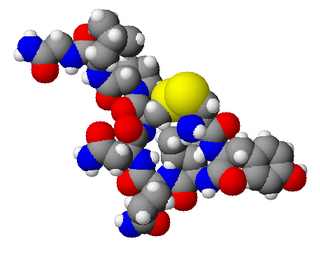Oxytocin
peptide hormone and neuropeptide From Wikipedia, the free encyclopedia
Oxytocin is a hormone found in mammals. It is a peptide hormone and neuropeptide. It acts on the brain. In humans it is released during female reproduction, especially during and after childbirth.[1]


It has other effects. It encourages pair bonding, and parental behaviour. It is released during intimate moments during orgasms and even hugs. For this reason it is often called the 'love hormone'.[2]
Strange to say, the oxytocin released by the pituitary gland cannot reach the brain: it does have effects on the rest of the body. The reason is that there is a blood–brain barrier which prevents large molecules from getting into the brain. Instead, the hormone is produced by special nerve cells inside the brain.[3]
Oxytocin is also released through the use of recreational drugs like MDMA and some prescription anti-depressants.[4]
Oxytocin was the first polypeptide hormone to be sequenced and synthesized, by Vincent du Vigneaud and colleagues in 1953.[5]
Related pages
References
Wikiwand - on
Seamless Wikipedia browsing. On steroids.
